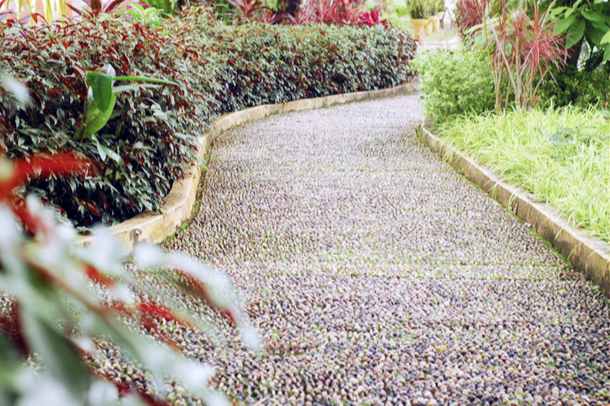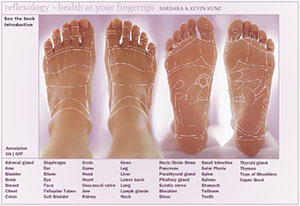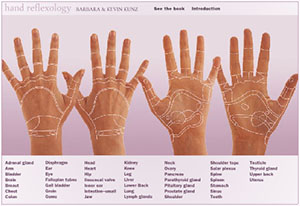Takefumi, Bamboo Stepping
Legend has it that the samurai warriors of old would chop down a piece of bamboo and walk on the rounded surface to promote strength and vigor. The strength of the sole was equated with strength of the soul, or so the story goes. The sole of the foot was viewed as the body’s second heart. Aging in some circles is seen as beginning with the feet. Takefumi is the name given to the tradition of walking on bamboo. “Take” is bamboo and “fumi” is to step upon. The takefumi tradition has been incorporated into the idea of a Stroll Path, walking on a variety of surfaces to stimulate the feet.
Does takefumi counteract the ever-present, downward pull of gravity? The foot is, afterall, the body’s basic interface with the ground. The enormous pressures experienced by a foot in a day’s time challenge the structural integrity of the foot. The foot is a sensory organ which is quite capable of meeting a variety of terrain. The repetetive sameness of the flat surface of the shoe and surface underfoot create a pattern of stress. If not interrupted, this pattern of stress can be harmful to the foot and to the rest of the body.
The body’s weight puts pressure on the sole’s pressure sensors. In addition, it challenges the muscles and bones of the foot. While unrelenting pressure causes the bones to become misaligned, muscles to weaken, and nerves to become irritated. This effect has been shown to have impact on other musculoskeletal parts of the body. The body is, thus, depleted of the finite amount of energy its requires for good health. With the simple fundamentals of takefumi, you can lift your arch while lifting your spirits.
How to do takefumi
To try using takefumi, first consider the level of challenge that is appropriate for you foot. Take the bamboo (PVC pipe or any rounded surface can be substituted) and place it with the rounded side up on the floor. While standing, place one foot on the bamboo. Slowly shift your body weight onto the bamboo. Note what you feel. Does your foot feel stressed? Unpleasantly stressed or pleasantly stressed? Do you find areas of extreme sensitivity?
If you find the takefumi to be too challenging to be comfortable, consider using a bamboo piece that is not as high off the ground. Or, start out in a seated position using one foot one top of the other to exert pressure and accustom your foot to the rounded surface. Gradually build up to the standing position.
If you feel the takefumi places a reasonable stress on your foot, try stepping on the bamboo with both feet. Take note of your response and stay within your comfort zone. This is a form of exercise. Start out gradually, spending a few minutes standing on the bamboo. If you feel after effects of walking on the bamboo, i. e. soreness in the foot, lessen the challenge. Shorten the amount of time you use the bamboo or use a smaller piece. If you have an existing foot problem or medical problems such as osteoporosis, consult a medical practitioner prior to proceeding.
Note your overall response to takefumi. Others have found their responses to be (1) more overall energy, (2) deeper sleep, (3) a more relaxed foot, and (4) a feeling of strength in the muscles of the foot, legs, abdomen, and lower back. Experiment with the bamboo. Standing in place, rock from side to side. Rhymically rocking from side to side, you can understand why the samurai warriors sought to use the practice of takefumi.
See also suggestions contained in Reflexology, Health at Your Fingertips in the chapter, “Health Pathways”
Bamboo Step Exercise Research by Barbara & Kevin Kunz
First it was walking on a Reflexology Path and now it’s the reflexology step exercise program. East has come West with yet another two studies showing the impact of reflexology ideas on the health-seeking senior citizen. First spotted in the bibliography of the Reflexology Path study1, the two Japanese studies note the merging of step aerobic exercise ideas with reflexology ideas to produce a popular low intensity exercise program forJapanese seniors. (See below.)
There’s nothing like a study to breathe fresh air into an idea. A few years ago two studies about oatmeal lowering cholesterol created demand for the breakfast food so great that oats could not be grown fast enough. At issue is the acceptance of an idea into the popular culture. Walking on a specifically desgned reflexology surface has moved into the popular culture in China and Japan and Germany. Is the US next? Will the spector of easy reflexology – all you do is stand or walk – move Americans to reflexology? Will the idea that reflexology walking is age appropriate and beneficial for senior citizens create a new wave of reflexology use?
In 1984, Kunz and Kunz first included in Hand and Foot Reflexology, A Self-Help Guide an idea for stepping on a broom stick or dowel to apply pressure to the feet. Furthers articles followed in Reflexions over the years.
Reflexology Step Exercise Programs Tested
Aotake is the Japanese word for green bamboo but it has taken on a larger meaning in Japan today. Aotake is the name given a low impact reflexology exercise program available at many Japanese health and sports clubs. Participants move in time to music stepping onto a “reflexology step,” a plastic strip about 2 1/2” high, 16” long and 3” wide. The strip is textured with raised bumps. The bumps provide reflex stimulation “thought by many to promote relaxation and promote balance throughout the body.”2 The program typically requires 40 minutes: 10 minutes of warm-up stretching and loosening, 30 minutes of aerobic Aotake step activity and 10 minutes of cool-down.
The Aotake step exercise program has achieved popularity as an “age appropriate” activity for most senior citizens. It is considered appropriate because, it involves low impact aerobics, no equipment other than an inexpensive Aotake step, easy-to learn dance steps, enjoyable music and reflex stimulation.
Now, two studies note that “aotake technique elicited significant changes in self-reported negative mood states (tension, anger, fatigue, depression, and confusion.)3
1.Fuzhong Li, Peter Harmer, Nicole L. Wilson, K. John Fisher, “Healthy Benefits of Cobblestone-Mat Walking: Preliminary Findings,” Journal of Aging and Physical Activity, 11(4), October 2003, p.11
2. Hayakawa, Y., Takada, K., Tanaka, K., & Asano, K. (2001). Effects of bamboo stepping exercise on mood state. Medicine and Science in Sports and Exercise, 33(5), S76.
In a study comparing the energy cost of Aotake stepping and stepping in place, “Aotake exercise was performed at a relatively low intension (46-51% of maximal oxygen uptake), suggesting that Aotake exercise is suitable as an introductory exercise progra for most older and middle- aged adults, including those with various chronic disorders. No differences were found between the
Aotake exercise and stationary walking conditions.”1
Researchers note that the stimulation of stepping onto the bumpy sufrace of the Aotake step is associated with reflexology, “an ancient form of holistic medicine found in many Asian coun- tries.” … When pressure is applied to these (reflex) zones, many Asian people believe that the nat- ural energy flow is released, helping restore homeostasis and balance to the body. … “Although these claims are difficult to evaluate scientifically, may seniors believe that aotake exercise relieves stres and tensioon and is generally relaxing. By combining elements of Western aerobic exercise and Eastern reflexology, Aotake draws from two quite different traditioons of healing. This combination is attractive to many Japanese seniors, who are increasingly exposed to both modern and traditional approaches to medicine and health.”









